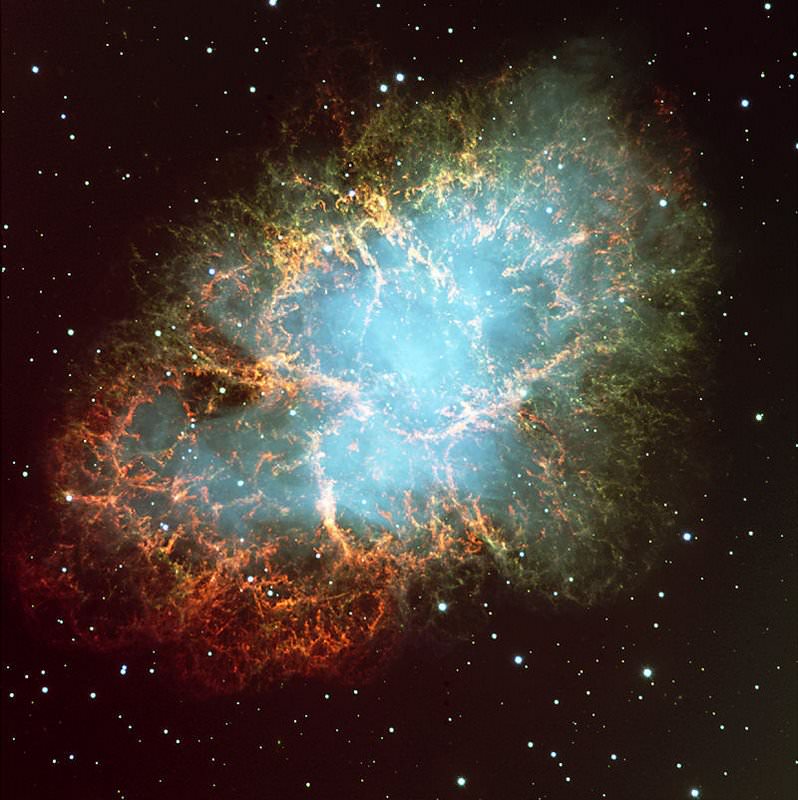In the 18th century, French astronomer Charles Messier kept noting the presence of fixed, diffuse objects in the night sky. Initially, he thought these were comets, which he was attempting to locate at the time. However, astronomers would later discover that these objects were in fact nebulae, galaxies and star clusters. Between the years of 1758 and 1782, Messier compiled a list of approximately 100 of these objects.
His intention was to ensure that other astronomers would not mistake these objects for comets. But in time, this list – known as the Messier Catalog – served a higher purpose. In addition to being a collection of some of the most beautiful objects in the night sky, the catalog was also an important milestone in the discovery and research of Deep Sky objects. The first item in the catalog is the famous Crab Nebula – hence its designation as Messier Object 1, or M1.
Description:
Messier 1 (aka. M1, NGC 1952, Sharpless 244, and the Crab Nebula) is a supernova remnant located in the Perseus Arm of the Milky Way Galaxy, roughly 6500 ± 1600 light years from Earth. Like all supernova remnants, it is an expanding cloud of gas that was created during the explosion of a star. This material is spread over a volume approximately 13 ± 3 ly in diameter, and is still expanding at a velocity of about 1,500 km/s (930 mi/s).
Based on its current rate of expansion, it is assumed that the overall deceleration of the nebula’s expansion must has decreased since the initial supernova. Essentially, after the explosion occurred, the nebula’s pulsar would have began to emit radiation that fed the nebula’s magnetic field, thus expanding it and forcing it outward.
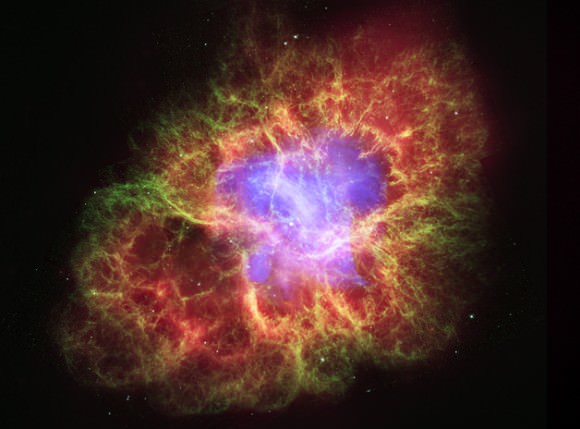
In visible light, the Crab Nebula consists of an oval-shaped mass of filaments – whose spectral emission lines are split into both red and blue-shifted components – which surround a blue central region. The filament are leftover from the outer layers of the former star’s atmosphere, and consist primarily of hydrogen and helium, along with traces of carbon, oxygen, nitrogen and heavier elements. The filaments’ temperatures are typically between 11,000 and 18,000 K.
The blue region, meanwhile, is the result of highly polarized synchrotron radiation, which is emitted by high-energy electrons in a strong magnetic field. The curved path of these electrons is due to the strong magnetic field produced by the neutron star at the center of the nebula (see below). One of the many components of the Crab Nebula is a helium-rich torus which is visible as an east-west band crossing the pulsar region.
The torus accounts for about 25% of the nebula’s visible ejecta and is believed to be made up of 95% helium. As yet, there has been no plausible explanation for the structure of the torus. And while it is very difficult to gauge the total mass of the nebula, official estimates place it at 4.6 ± 1.8 Solar masses – i.e 5.5664 to 12.7232 × 1030 kg.
Crab Pulsar:
At the center of the Crab Nebula are two faint stars, one of which is its progenitor (i.e the one that created it). It is because of this star that M1 is a strong source of radio waves, X-rays and Gamma-ray radiation. The remnant of supernova SN 1054, which was widely observed on Earth in the year 1054, this star was discovered in 1968 and has since been designated as a radio pulsar.
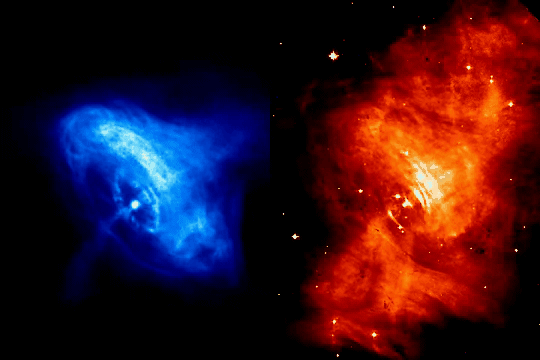
Known as the Crab Pulsar (or NP0532), this rapidly rotating star is believed to be about 28–30 km (17–19 mi) in diameter and emits pulses of radiation – ranging from radio wave and X-ray – every 33 milliseconds. Like all isolated pulsars, its period is slowing very gradually, and the energy released as the pulsar slows down is enormous. The Crab Pulsar is also the source of the nebula’s synchrotron radiation, which has a total luminosity about 75,000 times greater than that of the Sun.
The pulsar’s extreme energy output also creates an unusually dynamic region at the center of the Crab Nebula. While most astronomical objects only show changes over timescales of many years, the inner parts of the Crab show changes over the course of only a few days. The most dynamic feature in the inner part of the nebula is the point where the pulsar’s equatorial wind slams into the bulk of the nebula, forming a shock front (see above image).
The Crab Pulsar is also surrounded by an expanding gas shell which encompasses its spectroscopic companion star, which in turn orbits the neutron star every 133 days. This pulsar was the first one which was also verified in the optical part of the spectrum.
History of Observation:
The very first recorded information on this supernova event reaches as far back as July 4, 1054 A.D. by Chinese astronomers who marked the presence of a “new star” visible in daylight for 23 days and 653 nights. The event may have also been recorded by the Anasazi, Navajo and Mimbres First Nations of North America in their artwork as well.

In more modern times, the nebula was cataloged as a discovery by British amateur astronomer John Bevis in 1731, and independently by Charles Messier on August 28th, 1758 while looking for the return of Comet Halley. Although Bevis had added it to his “Uranographia Britannica”, Messier recognized what he had located had no proper motion, and was therefore not a comet. However, Messier did credit Bevis’ discovery when he learned of it years later.
By September 12th, 1758, Messier hit upon the idea of compiling a catalog of objects that weren’t comets, in order to help other astronomers avoid similar mistakes. Considering M1’s position, only slightly more than a degree from the ecliptic plane, this was a very good idea. Especially since M1 was again confused with Halley’s Comet when it returned in 1835.
The name Crab Nebula was first suggested by William Parsons, the Third Earl of Rosse, who observed it while at Birr Castle in 1884. The name was apparently due to the drawing he made of it, which resembled a crab. When he observed it again in 1848 using a ]telescope with better resolution, he could not confirm the resemblance. But the name had become popular by this point and has stuck ever since.
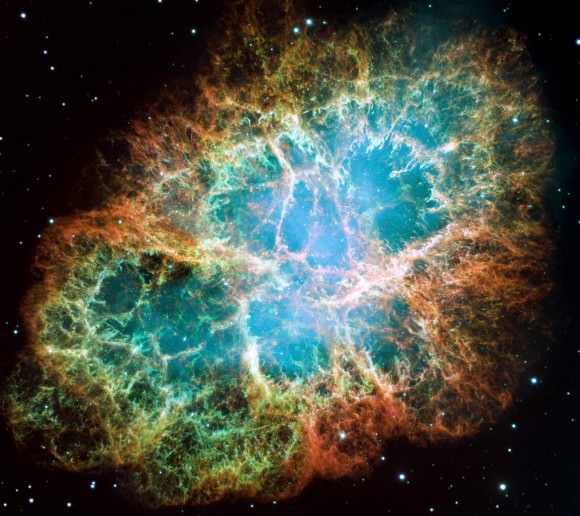
All of the early observers – including Herschel, Bode, Messier and Lassell – apparently mistook the filamentary structures of the Nebula as an indication of stellar structure. As Messier himself described it:
“Nebula above the southern horn of Taurus, it doesn’t contain any star; it is a whitish light, elongated in the shape of a flame of a candle, discovered while observing the comet of 1758. See the chart of that comet, Mem. Acad. of the year 1759, page 188; observed by Dr. Bevis in about 1731. It is reported on the English Celestial Atlas.”
Sir Williams Herschel’s writing on the nebula appeared in the 74th volume of the Philosophical Transactions of the Royal Society of London, which was released in 1784. As he described it:
“To these may added the 1st [M1], 3d, 27, 33, 57, 79, 81, 82, 101 [of Messier’s catalog], which in my 7, 10, and 20-feet reflectors shewed a mottled kind of nebulosity, which I shall call resolvable; so that I expect my present telescope will, perhaps, render the stars visible of which I suppose them to be composed…”
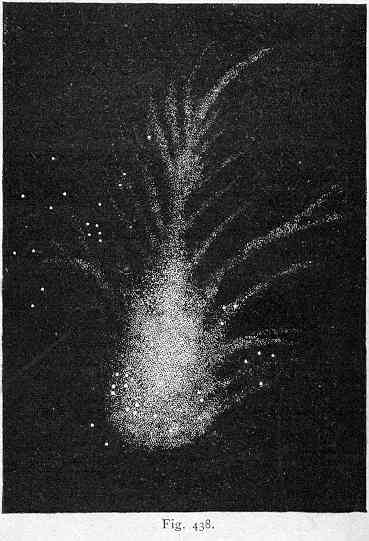
But it was Parsons (aka. Lord Rosse) who first recognized M1 for what we know it as today. As he recorded when viewing it for the first time (in 1844):
“Fig. 81 is also a cluster; we perceive in this [36-inch telescope], however, a considerable change of appearance; it is no longer an oval resolvable [mottled] Nebula; we see resolvable filaments singularly disposed, springing principally from its southern extremity, and not, as is usual in clusters, irregularly in all directions. Probably greater power would bring out other filaments, and it would then assume the ordinary form of a cluster. It is stubbed with stars, mixed however with a nebulosity probably consisting of stars too minute to be recognized. It is an easy object, and I have shown it to many, and all have been at once struck with its remarkable aspect. Everything in the sketch can be seen under moderately favourable circumstances.”
Locating Messier 1:
The Crab Nebula is easily visible in the night sky near the Taurus constellation, whenever light pollution is not an issue. It can be located by identifying Zeta Tauri, a third magnitude star located east/northeast of Aldebaran. With dark sky conditions, it can be seen as a tiny, hazy patch with binoculars and small telescopes with low magnification. If sky conditions are bright, it may be harder to locate with modest equipment.

With a little more magnification, it is seen as a nebulous oval patch, surrounded by haze. In telescopes starting with 4-inch aperture, some detail in its shape becomes apparent, with some suggestion of mottled or streak structure in the inner part of the nebula. To the amateur astronomer, M1 does indeed look similar to a faint comet without a tail.
As Messier 1 is situated only 1 1/2 degrees from the ecliptic, there are frequent conjunctions and occasional transits of planets, as well as occultations by the Moon. And for the sake of simplicity, here are the vital statistics on this Messier Object:
Object Name: Messier 1
Alternative Designations: NGC 1952, M1, Sharpless 244, Crab Nebula
Object Type: Supernova Remnant
Constellation: Taurus
Right Ascension: 05 : 34.5 (h:m)
Declination: +22 : 01 (deg:m)
Distance: 6.3 (kly)
Visual Brightness: 8.4 (mag)
Apparent Dimension: 6×4 (arc min)
We wish you luck in locating it in the night sky. And should you find it, enjoy your observations!
We have written many great articles about the Crab Nebula and Messier Objects here at Universe Today. Here’s What Is The Crab Nebula?, The Peculiar Pulsar in the Crab Nebula, and Top Five Celestial Objects Anyone Can See With A Small Telescope.
Be sure to check out our complete Messier Catalog.
For more information, check out the SEDS Messier Database.

